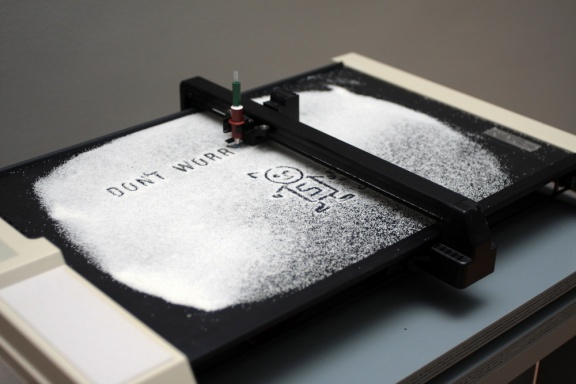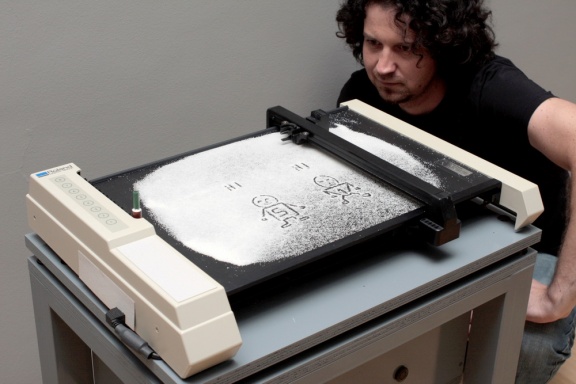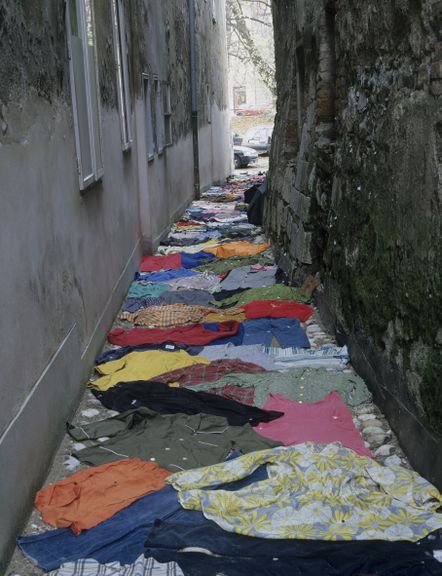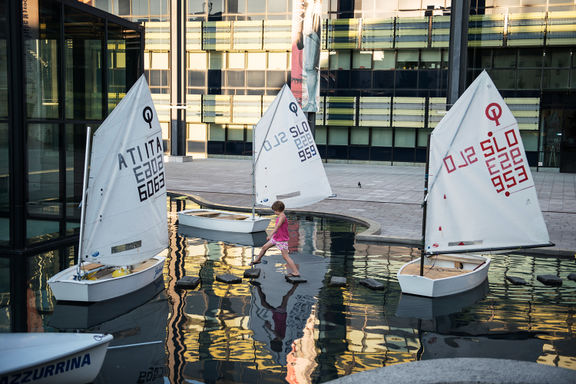Difference between revisions of "U3 Triennial of Contemporary Slovene Arts"
Maja Škerbot (talk | contribs) |
|||
| (58 intermediate revisions by 10 users not shown) | |||
| Line 1: | Line 1: | ||
{{Article | {{Article | ||
| − | | status = WRITING | + | | status = NEEDSUPDATE WRITING TOPROOFREAD NIFERTIK! |
| − | | maintainer = | + | | maintainer = Simon Žlahtič |
}} | }} | ||
| + | |||
{{Infobox | {{Infobox | ||
| − | |name = U3 | + | | name = U3 Triennial of Contemporary Slovene Arts |
| − | |street | + | | localname = U3 - trienale sodobne slovenske umetnosti |
| − | |telephone = 386 (0) 1 | + | | street = Maistrova 3 |
| − | |fax = 386 (0) 1 251 4120 | + | | town = SI-1000 Ljubljana |
| − | |email = | + | | telephone = 386 (0) 1 241 6825 |
| − | |website = | + | | fax = 386 (0) 1 251 4120 |
| − | | | + | | email = info@mg-lj.si |
| − | | | + | | website = https://www.mg-lj.si/si/razstave/2731/historiat-u3/ |
| − | |dates and duration = | + | | organised by = Moderna galerija / Museum of Modern Art, Ljubljana plus Museum of Contemporary Art Metelkova |
| + | | contacts = {{Contact | ||
| + | | name = Martina Vovk | ||
| + | | role = Acting Director | ||
| + | | email = martina.vovk@mg-lj.si | ||
| + | }} | ||
| + | {{Contact | ||
| + | | name = Sanja Kuveljić Bandić | ||
| + | | role = International projects manager | ||
| + | | email = sanja.kuveljic-bandic@mg-lj.si | ||
| + | }} | ||
| + | | frequency = triennially | ||
| + | | dates and duration = 3 months | ||
| + | | duration weeks = 24,25,26,27,28,29,30,31,32,33,34,35,36,37,38,39 (2013) | ||
| + | | festival dates = 20.6.2013 - 29.9. 2013, 3.6.2016 - 18.9.2016, 10.10.2019 - 31.12.2019, 1.1.2020 - 12.1.2020, 21.6.2024 - 17.11.2024 | ||
|photo = [[Image:U3 Triennial of Contemporary Slovene Arts.jpg]] | |photo = [[Image:U3 Triennial of Contemporary Slovene Arts.jpg]] | ||
| − | |||
| − | |||
}} | }} | ||
| + | |||
{{Teaser| | {{Teaser| | ||
| − | The U3 Triennial of Contemporary Slovene Arts was established in [[established::1994]] by the [[Museum of Modern Art | + | The ''[[U3 Triennial of Contemporary Slovene Arts]]'' was established in [[established::1994]] by the [[Museum of Modern Art|Moderna galerija]] with the aim to provide a periodic overview of the current situation in contemporary Slovene art through the subjective eye of a curator/selector, drawing attention to works which are, according to the selector, the best and closest to the sensibility of the time. To assure a certain level of objectivity, the selector of every second ''U3 Triennial'' is a foreign curator, since this emphasises the purpose of the event: to underline differences in aesthetic concepts as well as in professional, critical, cultural, political, and social positions. So far the triennial has been curated by [[Tomaž Brejc]], Peter Weibel, [[Gregor Podnar]], Christine Van Assche, [[Jurij Krpan]], Charles Esche, and [[Nataša Petrešin]]. The 2016 edition will feature artistic response on the topic of cosmos, proposed by Boris Groys. |
}} | }} | ||
| − | + | ==About editions== | |
| − | + | ||
| − | + | The curator of the first ''U3'' was the Slovene art historian and critic [[Tomaž Brejc]] who presented the horizontal survey of the "postmodern pluralism" but tackled also the degrading social status of the local artists. The second triennial of 1997 was curated by Peter Weibel, a multimedia curator, artist and writer, active at Zentrum für Kunst und Medientechnologie in Karlsruhe. Themes were dislocation, discommunication, medialisation, contextualisation, and a critique of the museum institution and art system. His edition of ''U3'' stirred a lot of local polemics mostly arguing the potent role of the curator. | |
| − | + | ||
| + | The 3rd triennial of 2000 entitled ''Vulgata'', was conceived by Slovene art historian and curator [[Gregor Podnar]], then the artistic director of the [[Škuc Gallery]], and questioned the Slovene national identity based on social constructs. Among others it exhibited the works of [[Marko Peljhan]], [[Tadej Pogačar]], [[Alenka Pirman]], [[Vuk Ćosić]], [[Marko Kovačič]], [[Damijan Kracina]], [[Darij Kreuh]], and [[Maja Licul]]. | ||
| + | |||
| + | The 4th triennial of 2003 with the title ''Here and There'' was curated by Christine Van Assche, a new media curator from the Musée national d'art moderne at the Georges Pompidou Centre in Paris. It concentrated on the concept of the museum, based on the supposition that museums have changed tremendously over the last fifty years. The shifting concept of museums was presented in 20 projects that expanded also through other mainstream channels: prints were exhibited on billboards throughout Ljubljana ([[Sašo Vrabič]]), a video was broadcast on TV ([[Davide Grassi]], [[Igor Štromajer]] and [[Brane Zorman]]), the exhibition included projections on the façade of the museum ([[Martin Bricelj]]), a music performance in a theatre ([[Random Logic]]), a project on the Internet ([[Andreja Kulunčič]]), and a project involving visitors' cell phones ([[Vuk Ćosić]]). | ||
| + | |||
| + | The curator of the 5th edition of ''U3'' (2006) was [[Jurij Krpan]], artistic director of Ljubljana's [[Kapelica Gallery]]. The exhibition was divided into 4 modules. The first one exposed the "good practices", which drew attention to the unexploited possibilities for improving the production conditions in the field of visual arts. The second module featured the exhibition of 11 selected new media art projects by [[Viktor Bernik]], [[BridA]], [[Srečo Dragan]], [[Nika Oblak and Primož Novak]], [[Mark Požlep]], [[Sašo Sedlaček]] and others. The third module, featured in the central room of the triennial, dealt with the analysis of the 20th-century production and public presentations. The fourth module consisted of panel discussions, talks and performances. Several representatives of international art institutions, centres, organisations and networks presented their artist-in-residence programmes. | ||
| + | |||
| + | The 6th edition of the triennial, ''Idea for Living'' [Kako živeti], was postponed to June 2010 because of the renovation of the [[Museum of Modern Art]]. It was conceived by Charles Esche, current director of the Van Abbemuseum in Eindhoven, who dedicated his research to the reflection on the notion of realism in contemporary art. His selection included the most Slovene artists since the triennial's inception. The exhibition was designed by [[Bevk Perović Arhitekti]] and also featured carefully selected historical works from the museum's collection as well as works by some key figures from the ex-Yugoslavian film and art scene. | ||
| + | |||
| + | The 2013 edition was curated by Paris-based Slovenian curator [[Nataša Petrešin]] and presented the activities of over 150 artists, designers, performers, musicians, architects, and others linked to some 30 different (international) artistic collectives, groups, platforms, networks and organisations that practice DIWO (Do It With Others) principle. The exhibition addressed the concept of ''Resiliance'', the intertwining of life and art to reach creative and existential sustainability. | ||
| + | |||
| + | In 2016 Boris Groys curated the ''Beyond the Globe'' edition, which also reached beyond the national framework of the triennial. | ||
==See also== | ==See also== | ||
| − | * [[Museum of Modern Art Ljubljana]] | + | * [[Museum of Contemporary Art Metelkova (MSUM)]] |
| − | * [[ | + | * [[Moderna galerija / Museum of Modern Art, Ljubljana plus Museum of Contemporary Art Metelkova]] |
| + | |||
| + | ==External links== | ||
| + | * [https://www.mg-lj.si/si/razstave/2731/historiat-u3/ Moderna galerija website on U3] | ||
| + | The triennials | ||
| + | *[http://www.mg-lj.si/en/exhibitions/1675/beyond-the-globe-8th-triennial-of-contemporary-art-u3/ The 8th ''U3'' Triennial of Contemporary Slovene Arts website] | ||
| + | * [http://u3trienale.mg-lj.si/en/about/ The 7th ''U3'' Triennial of Contemporary Slovene Arts website] | ||
| + | * [http://www.mg-lj.si/node/513 The 6th ''U3'' with recorded statements by C. Esche] on [[Museum of Modern Art]] website | ||
| + | **[http://www.artmargins.com/index.php/5-interviews/600-charles-esche-ljubljana-triennial-beyond ''Charles Esche on the Ljubljana Triennial, and Beyond'', interview on Artmargins website] | ||
| + | **[http://artycok.tv/lang/en-us/u3-6th-triennial-contemporary-art-slovenia/4655#more-4655 Video with Charles Esche's statement on Artyčok.tv] | ||
| + | **[http://www.endlesslowlands.nl/?p=3215 ''U3 Triennial en de Ljubljana art scene'' on Endless Lowlands blog] (in Dutch) | ||
| + | **[http://www.flickr.com/photos/50739950@N02/ Photos on Flickr] | ||
| + | * [http://www.e-flux.com/search?q=u3+ljubljana The ''U3'' on e-flux] | ||
| + | |||
| + | |||
| + | {{gallery}} | ||
| − | |||
| − | |||
| − | [[Category:Festivals]][[Category:Visual arts festivals]] | + | [[Category:Festivals]] |
| + | [[Category:Visual arts festivals]] | ||
| + | [[Category:Visual arts]] | ||
Latest revision as of 07:24, 2 August 2024
About editions
The curator of the first U3 was the Slovene art historian and critic Tomaž Brejc who presented the horizontal survey of the "postmodern pluralism" but tackled also the degrading social status of the local artists. The second triennial of 1997 was curated by Peter Weibel, a multimedia curator, artist and writer, active at Zentrum für Kunst und Medientechnologie in Karlsruhe. Themes were dislocation, discommunication, medialisation, contextualisation, and a critique of the museum institution and art system. His edition of U3 stirred a lot of local polemics mostly arguing the potent role of the curator.
The 3rd triennial of 2000 entitled Vulgata, was conceived by Slovene art historian and curator Gregor Podnar, then the artistic director of the Škuc Gallery, and questioned the Slovene national identity based on social constructs. Among others it exhibited the works of Marko Peljhan, Tadej Pogačar, Alenka Pirman, Vuk Ćosić, Marko Kovačič, Damijan Kracina, Darij Kreuh, and Maja Licul.
The 4th triennial of 2003 with the title Here and There was curated by Christine Van Assche, a new media curator from the Musée national d'art moderne at the Georges Pompidou Centre in Paris. It concentrated on the concept of the museum, based on the supposition that museums have changed tremendously over the last fifty years. The shifting concept of museums was presented in 20 projects that expanded also through other mainstream channels: prints were exhibited on billboards throughout Ljubljana (Sašo Vrabič), a video was broadcast on TV (Davide Grassi, Igor Štromajer and Brane Zorman), the exhibition included projections on the façade of the museum (Martin Bricelj), a music performance in a theatre (Random Logic), a project on the Internet (Andreja Kulunčič), and a project involving visitors' cell phones (Vuk Ćosić).
The curator of the 5th edition of U3 (2006) was Jurij Krpan, artistic director of Ljubljana's Kapelica Gallery. The exhibition was divided into 4 modules. The first one exposed the "good practices", which drew attention to the unexploited possibilities for improving the production conditions in the field of visual arts. The second module featured the exhibition of 11 selected new media art projects by Viktor Bernik, BridA, Srečo Dragan, Nika Oblak and Primož Novak, Mark Požlep, Sašo Sedlaček and others. The third module, featured in the central room of the triennial, dealt with the analysis of the 20th-century production and public presentations. The fourth module consisted of panel discussions, talks and performances. Several representatives of international art institutions, centres, organisations and networks presented their artist-in-residence programmes.
The 6th edition of the triennial, Idea for Living [Kako živeti], was postponed to June 2010 because of the renovation of the Museum of Modern Art. It was conceived by Charles Esche, current director of the Van Abbemuseum in Eindhoven, who dedicated his research to the reflection on the notion of realism in contemporary art. His selection included the most Slovene artists since the triennial's inception. The exhibition was designed by Bevk Perović Arhitekti and also featured carefully selected historical works from the museum's collection as well as works by some key figures from the ex-Yugoslavian film and art scene.
The 2013 edition was curated by Paris-based Slovenian curator Nataša Petrešin and presented the activities of over 150 artists, designers, performers, musicians, architects, and others linked to some 30 different (international) artistic collectives, groups, platforms, networks and organisations that practice DIWO (Do It With Others) principle. The exhibition addressed the concept of Resiliance, the intertwining of life and art to reach creative and existential sustainability.
In 2016 Boris Groys curated the Beyond the Globe edition, which also reached beyond the national framework of the triennial.
See also
- Museum of Contemporary Art Metelkova (MSUM)
- Moderna galerija / Museum of Modern Art, Ljubljana plus Museum of Contemporary Art Metelkova
External links
The triennials
- The 8th U3 Triennial of Contemporary Slovene Arts website
- The 7th U3 Triennial of Contemporary Slovene Arts website
- The 6th U3 with recorded statements by C. Esche on Museum of Modern Art website
- The U3 on e-flux







